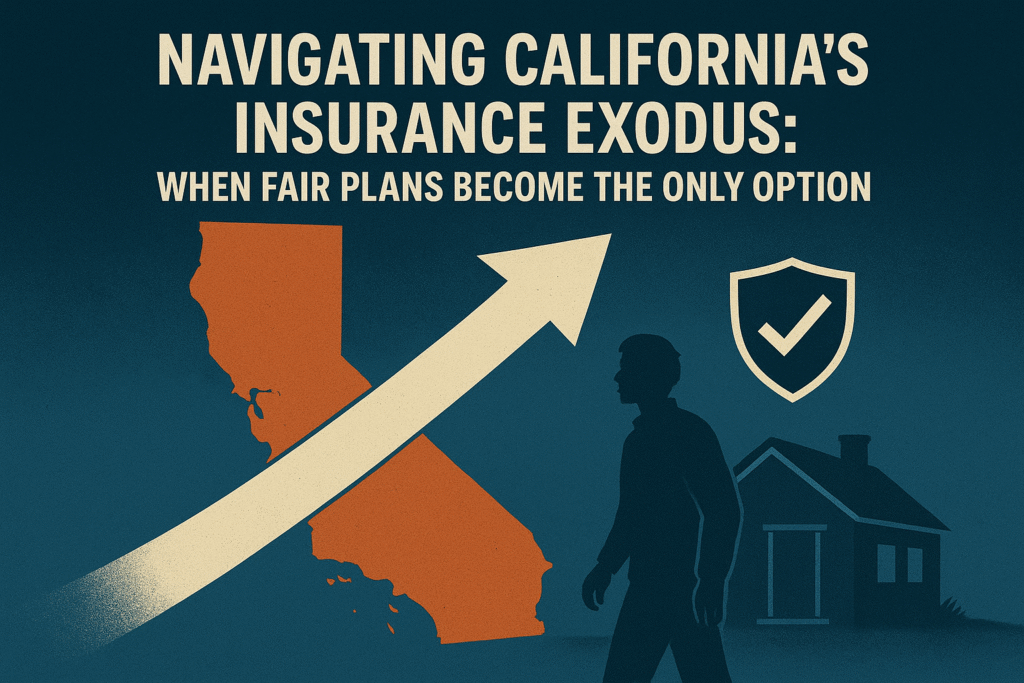As major insurers flee California’s insurance exodus, homeowners are facing a crisis. This guide explains why it’s happening, how the FAIR Plan works as a last resort, and your crucial next steps for securing coverage.
The Uninsurable Golden State
California, land of sun, innovation, and unparalleled natural beauty, is facing a quiet, escalating crisis that threatens the very foundation of homeownership. A mass departure of major insurance carriers—dubbed California’s insurance exodus—is leaving hundreds of thousands of residents scrambling for coverage. What was once a simple annual renewal has become a nightmare of non-renewal notices, skyrocketing premiums, and desperate searches for a policy.
The root cause is a catastrophic convergence of climate change and economics. Unprecedented wildfires, worsening droughts, and inflationary pressures have created a perfect storm where the risk of loss has outpaced the industry’s ability to price it profitably and predictably. Companies like State Farm, Allstate, and Farmers have responded by dramatically limiting new policies or pulling out of the state altogether.
In this alarming vacuum, a once-obscure safety net is being thrust into the spotlight: the California FAIR Plan. Designed decades ago as an insurer of last resort for a tiny fraction of high-risk properties, it is now becoming the only option for a rapidly growing segment of the population. This article is your essential guide to navigating this crisis. We will dissect the causes of the exodus, demystify the FAIR Plan, and provide a strategic roadmap for protecting your most valuable asset when the traditional market slams its doors shut.
Anatomy of a Crisis – The Drivers of California’s Insurance Exodus
This isn’t a random event; it’s a predictable outcome of systemic pressures. Understanding the “why” is key to navigating the “what now.”
1. The Climate Change Catalyst:
California has always been fire-prone, but the scale and frequency of recent wildfires are rewriting the rulebook. The 2017 and 2018 fire seasons were the most destructive in state history at the time, only to be dwarfed by the 2020 season, which burned over 4 million acres. For insurers, the traditional models based on historical data are useless. “Once-in-a-century” events are now happening annually, making risk assessment impossible and losses untenable.
2. The Reinsurance Domino Effect:
Insurance companies don’t carry all their risk; they themselves buy insurance, called reinsurance, to protect against catastrophic losses. As California’s fire risk has soared, global reinsurance companies have dramatically increased their premiums for carriers operating in the state. This cost is directly passed down, forcing primary insurers to either raise their rates to unsustainable levels or withdraw from the market entirely.
3. Regulatory Rigidity:
California’s Department of Insurance operates under Proposition 103, which requires prior approval for rate increases. While designed to protect consumers, this process is often slow and bureaucratic. Insurers argue that they cannot react quickly enough to the rapidly escalating risk and costs, creating a financial lag that makes the market unprofitable. This regulatory friction is a primary reason cited by companies like State Farm and Allstate for halting new policies.
4. Inflationary Pressures on Costs:
The cost of rebuilding a home has skyrocketed due to inflation in construction materials and labor. A policy written three years ago may not provide enough coverage to rebuild the same home today, increasing the insurer’s potential exposure. The “replacement cost” in a high-fire zone is now a staggering number that terrifies actuarial departments.
The result is a classic market failure: sellers (insurers) are unwilling to offer a product at a price buyers (homeowners) can afford, given the immense and unpredictable risk. This collapse of the private market is what triggers the need for a government-mandated solution.
The Last Resort Lifeline – Demystifying the California FAIR Plan
When no company in the standard market will insure you, the FAIR Plan becomes your only option. But it’s crucial to understand what it is—and what it is not.
What is the FAIR Plan?
The California Fair Access to Insurance Requirements (FAIR) Plan is a syndicated insurance pool established by state law. Every property and casualty insurer licensed in California is required to participate in it. It is not a state agency; it is a shared mechanism through which private companies collectively provide basic fire insurance to those who cannot obtain it in the traditional voluntary market.
Key Features (The Fine Print):
- It’s Bare-Bones Coverage: The FAIR Plan is a fire-only policy. It covers losses from fire, lightning, and internal explosion. It may offer optional extensions for smoke, hail, and civil commotion, but these cost extra.
- It is NOT a Homeowners Policy: This is the most critical distinction. A standard HO-3 policy includes liability coverage, theft, water damage, falling objects, and more. The FAIR Plan does not. It is a dangerously limited policy.
- Dwelling Coverage Limit: The maximum dwelling coverage is $3 million. For multi-million dollar homes in high-risk areas, this may be insufficient.
- It’s Often More Expensive: Because it pools the highest-risk properties, FAIR Plan premiums are typically higher than a standard market policy for equivalent fire coverage. You are paying more for less coverage.
Who is Eligible?
You must prove that you have been denied coverage by at least one traditional insurance carrier. Typically, you’ll need to provide copies of your non-renewal notices or declination letters from other companies.
The Critical Gap – Why a FAIR Plan Alone Is Not Enough
Relying solely on a FAIR Plan policy is one of the riskiest financial decisions a homeowner can make. Its limited nature creates massive coverage gaps.
The “Wrap” or “Difference in Conditions” (DIC) Policy:
To have comprehensive protection, you must pair your FAIR Plan fire policy with a separate DIC policy from a surplus lines insurer. This “wraps” around the FAIR Plan to fill all the gaps.
What a DIC Policy Covers (That the FAIR Plan Doesn’t):
- Liability Insurance: This is non-negotiable. If a guest is injured on your property, you are personally liable for their medical bills and legal fees without it.
- Theft and Vandalism: Coverage for burglary and malicious damage.
- Water Damage: Arguably the most common homeowners claim. This includes burst pipes, appliance leaks, and sewer backups.
- Falling Objects & Weight of Ice/Snow
- Personal Property: Coverage for the contents of your home (furniture, electronics, clothing).
- Additional Living Expenses (ALE): If a covered loss makes your home uninhabitable, ALE pays for hotel stays, meals, and other costs above your normal living expenses.
The Cost of Full Protection:
This two-policy solution (FAIR Plan + DIC) is invariably more expensive than a single, comprehensive homeowners policy was in the past. You are now dealing with two separate companies, two premiums, two deductibles, and the potential for coverage disputes in the event of a complex claim.
A Step-by-Step Action Plan for Homeowners
If you are facing non-renewal, don’t panic. Follow this strategic action plan.
Step 1: Don’t Wait for the Notice to Arrive
Be proactive. If you live in a ZIP code adjacent to a wildfire zone or have received any communication from your insurer about risk, start shopping now.
Step 2: Exhaust the Standard Market First
- Contact an Independent Insurance Agent: They have access to multiple carriers and can shop your policy around. Avoid captive agents who only represent one company (e.g., State Farm, Farmers).
- Consider Specialty Insurers: Some companies like Chubb, AIG, or PURE specialize in high-value homes and may be more willing to underwrite complex risks, though at a higher price.
Step 3: If Denied, Secure Your FAIR Plan Application
If the standard market says no, gather your declination letters and apply for the FAIR Plan. Your insurance agent can handle this process for you. Do not let your coverage lapse. A lapse can make it even harder to get insurance later and may violate your mortgage agreement.
Step 4: Immediately Secure a DIC Policy
This is not a step to delay. The moment you secure a FAIR Plan quote, contact your agent about finding a DIC policy to wrap around it. The surplus lines market for DIC policies is also becoming more competitive and expensive, so do this concurrently.
Step 5: Mitigate Your Risk (Become a Better Risk)
The best long-term strategy is to make your property more defensible and insurable.
- Complete Hardening Measures: Invest in a Class A fire-rated roof, ember-resistant vents, and dual-pane windows. Clear defensible space meticulously (100 feet or more).
- Get a CWPP Assessment: A Certified Wildfire Prevention Professional can assess your home and provide a report. Some insurers may offer discounts for this, and it demonstrates proactive risk management.
- Shop Annually: The market is fluid. Even if you’re on the FAIR Plan this year, new, specialized carriers may enter the market. Have your agent re-shop your coverage every renewal period.
The Road Ahead – Is There a Solution to the Exodus?
The FAIR Plan was never designed to be a mass-market solution. Its rapid growth is unsustainable and signals a deep market failure. Long-term solutions are complex but necessary.
1. Regulatory Modernization:
There are calls to modernize Proposition 103 to allow for more forward-looking risk models that incorporate climate data, rather than relying solely on historical losses. This could give insurers more confidence in their pricing.
2. State-Backed Reinsurance:
Some propose a state-backed reinsurance fund to help backstop insurers for catastrophic losses, similar to Florida’s Citizens Property Insurance Corporation model. This would cap the extreme losses that scare private reinsurers.
3. Mandatory Hardening and Mitigation:
Tying insurance incentives to proven mitigation efforts could help bridge the gap. Legislation that provides tax credits or grants for home hardening could reduce overall risk and make insurers more willing to write policies.
4. The FAIR Plan Reckoning:
The enormous growth of the FAIR Plan concentrates massive risk onto the balance sheets of the very insurers who are fleeing the state. This creates a paradoxical and unstable situation. A day of reckoning, where the FAIR Plan itself requires a bailout or drastic reform, is a real possibility if the exodus continues.
Conclusion: Navigating the New Normal
California’s insurance exodus is not a temporary blip; it is the new normal for homeownership in an era of climate change. The FAIR Plan has become an essential, if flawed, lifeline for hundreds of thousands of residents who played by the rules but now find themselves in the crosshairs of a global crisis.
Navigating this landscape requires vigilance, proactive risk management, and a clear understanding that the old rules no longer apply. Securing adequate coverage now means thinking in terms of multiple policies, higher costs, and a renewed focus on making your property defensible.
The path forward is uncertain, but for now, the immediate task for homeowners is clear: understand your risk, secure your FAIR Plan coverage without delay, and—most critically—ensure it is wrapped in a robust DIC policy. In the uninsurable Golden State, this two-policy solution isn’t just an option; for a growing number, it is the only remaining shield against financial catastrophe.


